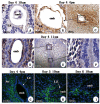Annexin A2 Acts as an Adhesion Molecule on the Endometrial Epithelium during Implantation in Mice
- PMID: 26444699
- PMCID: PMC4596619
- DOI: 10.1371/journal.pone.0139506
Annexin A2 Acts as an Adhesion Molecule on the Endometrial Epithelium during Implantation in Mice
Abstract
To determine the function of Annexin A2 (Axna2) in mouse embryo implantation in vivo, experimental manipulation of Axna2 activities was performed in mouse endometrial tissue in vivo and in vitro. Histological examination of endometrial tissues was performed throughout the reproduction cycle and after steroid treatment. Embryo implantation was determined after blockage of the Axna2 activities by siRNA or anti-Axna2 antibody. The expression of Axna2 immunoreactivies in the endometrial luminal epithelium changed cyclically in the estrus cycle and was upregulated by estrogen. After nidatory estrogen surge, there was a concentration of Axna2 immunoreactivities at the interface between the implanting embryo and the luminal epithelium. The phenomenon was likely to be induced by the implanting embryos as no such concentration of signal was observed in the inter-implantation sites and in pseudopregnancy. Knockdown of Axna2 by siRNA reduced attachment of mouse blastocysts onto endometrial tissues in vitro. Consistently, the number of implantation sites was significantly reduced after infusion of anti-Axna2 antibody into the uterine cavity. Steroids and embryos modulate the expression of Axna2 in the endometrial epithelium. Axna2 may function as an adhesion molecule during embryo implantation in mice.
Conflict of interest statement
Figures




References
-
- Das SK, Wang XN, Paria BC, Damm D, Abraham JA, Klagsbrun M, et al. Heparin-binding EGF-like growth factor gene is induced in the mouse uterus temporally by the blastocyst solely at the site of its apposition: a possible ligand for interaction with blastocyst EGF-receptor in implantation. Development. 1994;120(5):1071–83. - PubMed
-
- Lim H, Paria BC, Das SK, Dinchuk JE, Langenbach R, Trzaskos JM, et al. Multiple female reproductive failures in cyclooxygenase 2-deficient mice. Cell. 1997;91(2):197–208. - PubMed
-
- Dominguez F, Garrido-Gomez T, Lopez JA, Camafeita E, Quinonero A, Pellicer A, et al. Proteomic analysis of the human receptive versus non-receptive endometrium using differential in-gel electrophoresis and MALDI-MS unveils stathmin 1 and annexin A2 as differentially regulated. Hum Reprod. 2009;24(10):2607–17. 10.1093/humrep/dep230 - DOI - PubMed
MeSH terms
Substances
LinkOut - more resources
Full Text Sources
Other Literature Sources

